Guest Editorial
The forgotten lands
The Agasthyamalai mountain is beautiful; it has the conical Podigai peak, cool and dense forests, refreshing waterfalls and of course the Manjolai tea estates. But the vast eastern plains off the mountains and stretching all the way to the Bay of Bengal that are green with paddy fields, hot and arid in many places, is a landscape that in popular memory remains a rice bowl or a place for old temples. Not many know that Tirunelveli and Thoothukudi districts also had vast stretches of grass and scrub lands called Paalai which were used and admired by local people as discussed in an article in this issue. In 1874, 16 chivangi or the cheetah were killed at Tirunelveli alone. Migrant white storks frequented the grasslands but not anymore and what remains today are over grazed patches where Blackbucks, few grassland birds and the local Konar communities eke out a precarious living. We as humans value these lands because we can convert them to housing plots, industrial area or bring water and grow paddy or make it gated agricultural estates. All this can be done with relative ease as the government policy still considers these as wastelands in spite of growing evidence of how valuable grasslands are for the local biodiversity it harbors, the ecosystem services it provides and the livelihood it supports. We focus this issue of Agasthya on such unsung and forgotten landscapes in the Agasthyamalai region. The suite of articles tells you what these places have and how little we care for them. As in many other parts of India, here too grasslands appear as a lost hope but let's be clear that it's much easier to restore them back unlike complex rainforests in the hills only if the arid land is left alone for some time and prevent invasion by the Karuvai. So if we collectively work and have the will we can make the Paalai lands regain its glorious past.
- T Ganesh
Thriving in the shadow of Agasthyamalai - Paalai and its plants
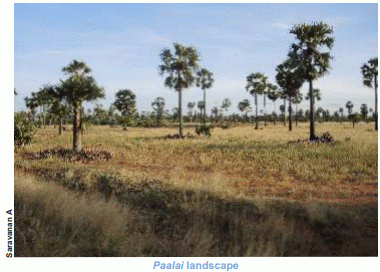
Agasthyamalai is credited for the water sources that transform the parched landscape of southern Tamil Nadu to emerald green fields and getting the fame of being the 'rice bowl' of southern Tamil Nadu. The same Agasthyamalai should be credited for a landscape element that has been classified as Paalai in the ancient times. Paalai, the arid landscape of southern Tamil Nadu is the resultant geographical element of towering peaks and insurmountable mountain ranges of Agasthyamalai. The whole area, being in the rain shadow zone, receives scanty rainfall compared to the western slopes of the Agasthyamalai. In addition to this, the high velocity south westerly wind after drenching the western slopes of Agasthyamalai become so dry that they take away moisture from the eastern slopes towards Bay of Bengal. Clay and red soil of this arid zone lend a characteristic vegetation to the Paalai landscape. Specially the black clayey soil, which by its natural characteristics, support grasses, reeds and trees such as acacia that comprise the typical thorny scrubs of the landscape. The red soil to some extent supports trees largely of acacia and toddy-palm, the landmark tree of southern Tamil Nadu.
Paalai landscape, known for its aridity and brave warriors, supported a culturally rich civilization as proven by excavations at Athichanallur, situated close to the Vallanadu Blackbuck Sanctuary. The ancient seaport at Korkai, known for its pearl fishery, which was the capital of the Pandiyan Kingdom, is located in the landscape. There are anecdotal evidences that the Paalai supported 'chivangi' the extinct cheetah and its prey the 'pulluva' called blackbuck, still seen around Vallanadu forest. British botanist Robert Wight, who explored the Courtallam Mountains with the linguist and historian Robert Caldwell in the early nineteenth century, found the arid landscape of ' Palamkottah' a rich hunting ground for plants.
Many new plants have been discovered from this arid landscape. 'Veruvettu' (Dalbergia coromandeliana) have branches with pointed tips and the whole plant look so unapproachable. Smaller plants have thick leaves with spiny margins or spiny tips. All these morphological features are reflecting the adaptive features of plants to escape from grazing as these are all extensively grazed by goat and sheep. These plants invest more resources in developing extensive and efficient root system than the branches that are seen above the soil. The roots penetrate deep into the soil to escape drought and their branches crawl over the soil in such way that they escape grazing by goat and sheep. In fact, these plants act as nursing plants for many herbaceous plants which do not have protective adaptations.
Though these hardy plants look repulsive they have immense therapeutic values to human as well as to cattle. After the rains many plants appear from the cover of the spiny plants with beautiful flowers while the low lying pockets and ponds in the arid lands gets covered with bladderworts, sundew plant and sedges. Rocky outcrops that support certain fleshy plants called Caralluma, come into life by bearing bizarre flowers that smell like rotting meat. Plants that escape dry season through tubers and bulbs come into life from the covers of rocks and thorny plants. The tubers and bulbs of Theriophonum, Scilla, Urginea are very beautiful.
Though officially classified as 'wastelands' by the Government, the arid or parched Paalai landscape, brimming with diverse plant life, inspired the poets of ancient time and supported rich cultural heritage called Thenpandi Nadu. The land now is getting transformed in the most ruthless way and the life that inspired poets and supported people and livestock is being lost rapidly. It is time our policy makers and government leaders learn to value the rich cultural and biological treasure endowed to us through the Paalai.
-R Ganesan
rganesan@atree.org
Vallanadu Blackbuck Sanctuary- A treasure in Thoothukudi arids
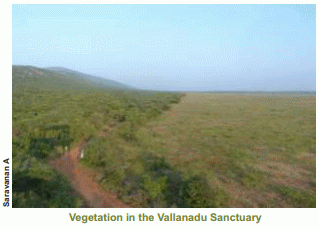
Last year the ACCC team had an opportunity to work with the forest department to develop a plan for the water management of Vallanadu Blackbuck Sanctuary (VBS). VBS has vast area covered with thorny scrub in Thoothukudi district, Tamil Nadu. When we first visited the sanctuary we noticed a tree without any leaf but full of yellow flowers near the entrance of the park. Although I am trained in botany, I could not identify the tree immediately. I have worked in many other regions with thorny forests, but never came across this particular tree anywhere. I came back and after referring to books, I identified the tree as Tecomella undulata (Family: Bignoniaceae). Further, digging into the literature I realized that it was introduced from the Thar Desert and thus went by the common name of 'desert teak'.
Documenting plants was a part of this study. I observed vegetation of this sanctuary which was comparable to my earlier study site in Theni and Dindigul districts where Acacia planifrons and Euphorbia antiquorum and in some cases, Commiphora berryi dominated the sites. The VBS however had complex mixed vegetation types, very dense scrub in most places where one can hardly enter while hill tops had some tall trees with dense undergrowth and open areas had some grasses.
Overall, I recorded more than 350 species of plants which belonged to 70 families. The dominant species were Acacia horrida tree, Ziziphus oenoplia a straggling shrub and Pavonia odorata an undershrub. Caralluma bhupinderiana of Asclepiadaceae was recently discovered from VBS. Species such as Euphorbia balakrishnanii, Crotalaria globosa and Dalbergia coromandeliana which are endemic to Tamil Nadu were seen here. More than 15 exotic species were detected of which Parthenium hysterophorus, Acanthospermum hispidum and Ageratum conyzoides were common. Interestingly, I found Typha angusta, a wetland plant in small stream at southwest side of the sanctuary.
Threats to the plant community comes from plants themselves as invasive plant species are colonizing the area. Though the aggressive Lantana camara and Prosopis juliflora are still restricted to few places, they are bound to become more common if suitable habitat management measures are not implemented to prevent them from colonizing open areas suitable for blackbuck. Nearly 30% of the VBS is planted with thorny tree Acacia mellifera. This is a very hostile habitat for most species either animal or plant as the hooked thorns hinders movement of animals and there is hardly any regeneration below the trees.
In all, I enjoyed this study. We stayed in a watchtower, started field work at 6 am to avoid the hot mid-day sun. Apart from the interesting plants, I could see a hedgehog, a pangolin den and a nightjar, all of which were lifers.
- Saravanan A
saravanan.amavaasai@atree.org
Butterflies of Vallanadu
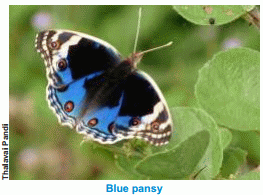
For the first time I was part of ATREE's research team, and my job was to assess the butterfly diversity of Vallanadu Blackbuck Sanctuary. Vallanadu was entirely different from KMTR, where I had earlier accompanied ATREE researchers. The primary difference was that the vegetation was short and scrubby. The sanctuary was gridded and I was asked to survey every cell. I was hoping to see all the colourful butterflies that we generally encounter in KMTR. To my surprise, lycaenids dominated the place and the trouble started for me. Because these are tough group to identify I was a little lost. I was assigned the responsibility of providing the butterfly list within the limited time of 2 days. Everything looked new. I had to think of a strategy to do a proper survey.
I armed myself with camera and started photo-documentation and got back to base camp and started to identify the species. The most common among lycaenids were the grass jewel, which I encountered in huge numbers. The pansies - blue, yellow, chocolate and lemon were common too. The trip gave me the opportunity to make observations on butterfly behavior. The blue pansy was defending territory while butterflies from the family pieridae such as white orange tip, large salmon Arab and common gull were seen flying here and there. Some such as common grass yellow, common gull, common jezebel, crimson tip and small orange tip were observed resting. During the survey I encountered a check dam which was to serve as the water hole for many animals such as Blackbuck, spotted deer and grey mongoose. This helped butterflies too, as I saw common rose mud-puddling on the bank of this tank. I still was looking for the most elegant among the butterflies the papilionids (those belonging to the family Papilionidae) known as swallowtails, when suddenly came the `Malabar raven' which was a first sighting for me.
- Thalavai Pandi
enviropandi@gmail.com
Bronzeback tree snake - The undertaker
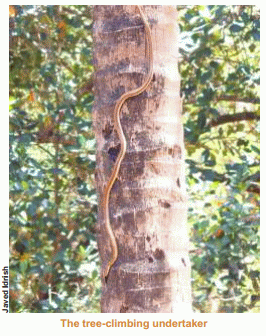
One of the most common snake in the arid region is the bronze back tree snake (Dendrelaphis tristis¸ known as Komberi Mukkan in Tamil) non-venomous and, mostly lives on trees. Locally however, it is believed to be venomous. They can be easily identified by slender long body, head slightly distinct from neck and longer tail. It is brown in dorsum and white underside. The snake shows a blue colour on the back when being threatened. This snake mainly feeds on lizards, frogs, geckos and there are few records where it is known to feed on other snakes.
According to a local myth, the snake quickly climbs a tree after biting a person and is believed to come down only after it observes the final rites of the victim. So as a remedy, when a person is bitten by this snake, the common practice is to burn a lot of dry leaves in the base of the tree in order to make the snake believe that the victim has been cremated. I have come across many such instances when traveling through the dry regions of not just Tirunelveli and Thoothukudi districts but also across other parts of rural Tamil Nadu. A plausible explanation of such a behaviour is because it is an arboreal species and it is but natural for them to retreat to its most favourable and safe habitat when it feels threatened. Because of the heat that the fire generates, the snake probably comes down. But this leads people to think that the snake came down believing that the victim's last rites have been performed. Such behaviour, in turn lend strength to their myth. Most of the times unfortunately, when the snake comes down, the vindictive people chase and kill it.
- Surya Narayanan
isha.surya06@gmail.com
Spiny beauty of the parched landscape
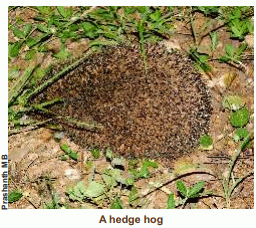
India has three species of hedgehogs - the long eared hedgehog, Indian hedgehog and the Madras hedgehog (MH). I have been following MH, a little fellow with hard, sharp and white-tipped with white outlines in the fur. MH has white furry chest and skinny belly. It has rightly been named by Horsfield in 1851 as Paraechinus nudiventris 'nudi' meaning nude and ventris meaning ventral side.
Hedgehogs do not have a long tail like rats and mice. Instead they have a tiny imperceptible tail. Unlike rats and mice their incisors are not sharp enough to guard them from enemies. So as defense strategy whenever the animal feels threatened or startled, it pulls its head and legs towards the belly and curls into a ball exposing only the spines to protect itself. And this is exactly what the little thing did on one occasion when I held it in my palm and it gave a nasty prick. Hedgehogs are slow moving but when the need arises they move fast. They are generally 'I-need-my-own-space' kind or in other words they are solitary in nature.
For some reason I have been fascinated with hedgehogs. For many years though, I was grappling with secondary information because of the elusive nature of the species. But one evening everything changed as I received a phone call, Naveen in Nanguneri (Radhapuram) claimed to have sighted a 'mulleli' the local Tamil name for hedgehogs. I was still wary of this reporting because I had enquired for its presence in the same town for several days. With a lot reluctance, I took my bike and rode to the spot and there among the bushes, lay a figure not unlike a pincushion. The 'karuvela' trees (Prosopis juliflora) stood around us in the bright red soil. I was sitting quietly watching him. Sensing my presence it did not move at all. Suddenly it quivered and brought out its legs and nose, looked at me and froze. Time stood still as we looked at each other. And just as it moved, my heart jumped with joy. His gentle walk held me spellbound. As I watched, it walked into the bushes. This was my maiden encounter with the Madras hedgehog. I stood transfixed to the spot with mixed emotion, unable to believe it, but this opened out many new avenues and pathways for me and I feel that the journey has just begun.
- Brawin Kumar
brawinkumarwildlife@gmail.com
Bos of Vallanadu
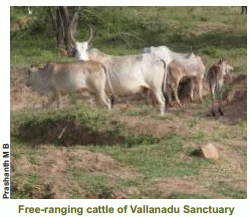
The most ubiquitous animal of Vallanadu, we were told, was the feral cattle. On the first trip the watcher showed us some clearings with hatched branches and sticks and told us that people had tried to catch the feral cattle here from a nearby village. We found more evidence of the animal as we walked trails and cut across impenetrable scrub in search of blackbuck signs. We saw some goats grazing up the Vallanadu hill and on the eastern ridge as we ambled up the rock we saw only cattle dung all over the place and rightly Prashanth called it the cattle ridge. It appeared as if the whole herd was operating from this camp on top of the hill. But the sighting of the ubiquitous cattle was still elusive and in the 4 days that we walked across the sanctuary which was hot and dry in early October we had a glimpse of them only twice. When we came back in January, the sanctuary had received some rains, the grass had turned green and the place looked damp and dense. We walked late in the evening to set camera traps and as we pushed through the dense vegetation humming with insect activity we could hear stampede and the deep moan of the feral. They were literally around us and not too happy, we intruding into their domain. The forest watcher cautioned us not to get surrounded by them as they can be dangerous. Over the next few days we only saw herds of these animals all in good condition and with several young ones. Unlike village cattle these were very wary of us and kept a good distance, they were truly wild and feral with large herd size. They seemed to be comfortable in the thorny undergrowth and when disturbed they just bolt through the vegetation sending stones and rubbles tumbling down the slope. I wondered if their thick skin had become thicker to prevent being spiked by the thorns. It appears that the Vallanadu sanctuary is used as a refuge by the feral during monsoon when there is plenty to eat in the forests while in summer they range widely over the plains mingling with domestic livestock and probably return to the sanctuary at night.
Where did these ferals come from? Nobody seemed to be sure. But it's possible that people abandoned some animals during drought and they wandered and managed to find sanctuary within Vallanadu. The grassland around the sanctuary and the water made available by the FD for the blackbuck served the feral cattle well. The management plan of Vallanadu estimated over 100 ferals in the early part of the century and that probably still holds good. The ferals are hunted by people once a while with great difficulty for the village feast but this seemed to have no or negligible impact on their population. However, it has made them extremely wary of humans. The feral seems to be outcompeting the wild ungulates in the sanctuary, particularly in the absence of any natural predator and right now the situation doesn't seem conducive for the wild fauna. Only a disease can probably reduce their population and relax the pressure on wild ungulates of Vallanadu.
- T . Ganesh
tganesh@atree.org
Where the buck does not stop for the Blackbuck
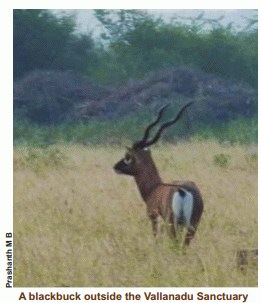
My first introduction to Vallanadu came through a call from Mathivanan, when he informed me about a survey that ACCC was supposed to carry out at Vallanadu Blackbuck Sanctuary (VBS). The study, commissioned by the forest department, required us to map the distribution of large and small mammals in the sanctuary in relation to some pre-existing conditions that had to do with location of check dams, thick vegetation of exotic species and the good old problem of not actually finding the charismatic blackbuck within the sanctuary. Only a small tract of grassland were within the protected area and thus most blackbuck roamed outside the sanctuary in human dominated grassland areas.
Mapping their distributions meant getting back to old topo-sheets and some maps made by the forest department. Vallanadu, a small hill about 30 km from the coast historically would serve as a landmark to the sailing ships towards Thoothukudi. A small little bulge on the shore could be a natural landmark since the towering hills of KMTR were much further away to be seen on the horizon.
Grids were drawn to comb the presence of small and large mammals which led to harsh back-bent walks, where most often the cap and clothing would get caught in the thorns. It was a very dry landscape and that the only water source was situated outside the sanctuary, made matters worse.
Most encounters of mammals within the sanctuary came from indirect evidences, barring solitary sightings of blackbuck jumping across the fence when disturbed, a fox, and presumably few individuals of released sambar and spotted deer. However, the most abundant of the mammals were huge herds of feral cattle that would run free and could turn aggressive on any instances of trying to approach them. The feral cattle, yet another historic problem in the sanctuary were to be seen on tank beds, walking up the high ridges and herd collectively at the peak under shade. Free ranging dogs were other encounters, chasing peafowl, hares and even bringing down some of them.
In total, the hill and the scrub offered little solace to the buck, unless when disturbed or one would imagine to browse during fruiting periods. On the other side, in the open land outside the sanctuary, changing land use looms large upon their chances of survival. The land is used for grazing and does not lead to conflict because of no agricultural activity. However, the buck wandering into a proposed residential layout with painted fence posts and markers were signs of things to come for them.
- Prashanth M B
prashanth.mb@atree.org
An evening with Konars
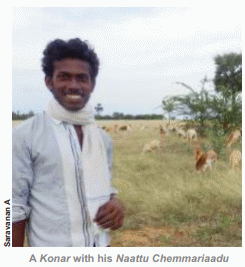
On a scorching summer day we started on our trail looking for the Edaiyars, a little known pastoral community inhabiting the southern districts of Tamil Nadu. We were interested to know about their plight in the light of rapidly shrinking pastoral grounds. Edaiyars, known as Konars, are traditional herders who straddle Tirunelveli and Thoothukudi districts in search of pasture for 'Naattu-chemmariaadu' (Tamil: a local breed of sheep). How and where do we start even our reconnaissance survey was an issue. Our savior was none other than ACCC staff Muthaiah. He popped out a mobile number and said that Perumal, an Edaiyar, was right there in Singampatti. As he was speaking to Perumal to fix a late evening appointment, Mathivanan, Saravanan and I got busy, dug up the questionnaire we had earlier designed and rushed to the spot. Without much difficulty, we found Perumal, who was trying to herd his sheep into the designated coconut grove whose owner had offered him a fee to camp there. The camping sheep enriches the fields with urine, pellets and hair. He and his aides were running hither and thither, trying to hush up the ewes with lambs into the pen. Once they settled down, he left them behind with his fellow herders to cook the night's meal and that was when we sat down to chat with him. It seemed that Singampatti was his preferred summer grazing ground where he could exploit the fallow period, when the grasses were left to take over the fields. From here he was planning to move to Tirunelveli and Azhwar Thirunagiri where his sheep will glean out the leftovers from the `ulunthu' (black gram) cultivation. Soon he will return to Singampatti just after the second paddy harvest of the year. With the arrival of SW monsoon in June, the plains abutting the eastern slopes of the Western Ghats, receives gentle drizzle which helps in the resprouting of grass and Perumal will head back home to Peikulum.
His annual journeys started at a tender age of 12 when he first joined his father, herding sheep from Peikulum to Singampatti. As far as his and his grandpa's memory go, they never had any other means of livelihood. For a greater part of the year, they were out of their village since nomadic grazing was the only option to sustain a herd size which often exceeded 200 sheep. 'Naattu chemmariaadu' needs to walk long distances to stay in good health and thus are best suited for the arid landscape which gets sporadic lush of grasses. A small patch of agricultural land that he owns is too meagre and is often subsidized through the income raised from sheep rearing. Although such limitations restricted his choices, he seemed very fond of his nomadic life.
Finally we steered him to answer the question on shrinkage of pastoral grounds - he said his summer grounds which are paddy fields in water rich areas are being converted to housing plots. Back in his village, people from the neighbouring state of Kerala, are buying vast stretches of the `meichalporamboku' (grazing commons), to set up private plantations through patta (tenured) land deals. The last remaining commons are now far apart between vast stretches of private land, which was exactly the contrast to the situation when his grandfather grazed his herd. With a sigh he said with these changes his wanderings are getting extended from six months to more due to these conversions and so does the distance with his loved ones.
- Soubadra Devy
soubadra@atree.org
Land mafia and Pulluva
Pulluva, the Tamil common name of blackbuck has its origins in 'pullu', the Tamil word for grass, on which the blackbuck grazes. Vallanadu Blackbuck sanctuary is the southernmost habitat for blackbuck which is situated near Tirunelveli and is among the five blackbuck habitats in Tamil Nadu. The sanctuary is very small in area (14.5 sq.kms) and is overgrown with thorny scrub. In the past, blackbuck roamed the adjacent open landscapes which are now being converted into quarries, residential plots, highways etc. Other than blackbuck, spotted deer, sambar deer, black-naped hare, Madras hedgehog are frequently encountered here. Sizeable feral cattle population has been recorded in the sanctuary which competes with blackbuck for grazing as well as water. There are no perennial streams and grasslands in the sanctuary. Forest Department sunk bore wells at few points to make water available for the animals. 'Erattaikinaru' (double well), which is the only other perennial source of water adjacent to the sanctuary is being converted to housing plots. The land around the sanctuary are grazing grounds for blackbuck and other herbivores. However, these grazing lands around the sanctuary are now being converted to housing plots which places the blackbuck under severe threat. The land mafia do not allow anyone to enter the area to see the blackbuck which continue to graze the lands. When one of our volunteers went there to photograph some blackbuck, some goons from land mafia threatened him, and forced him to delete all the photographs he had taken from the area. He was asked to leave the place and never to return to the area again. Blackbuck have been living here for centuries without any major conflict with the local farmers. The land adjacent to the sanctuary was being used for livestock grazing for many years. Sadly, the recent conversions of such grazing lands into real estate seemed to affect cattle grazers and the blackbucks. The forest department should attempt to take positive remedial measures such as acquiring the adjacent land and protecting it from the land mafia to preserve the grazing grounds of the blackbuck and the cattle.
- Mathivanan M
mathi@atree.org
Importance of ground water recharge in Nanguneri
Land use and land cover changes can impact the water and energy balance, directly affecting the climatic condition. They may impact food security through the conversion of agricultural land into industrial use and for urban expansion. Tamil Nadu, with low precipitation, is a water starved state and is dependent on other states for its water needs. The average annual rainfall of the State is 91 1.6 mm, and almost 100% of the surface water and 86% of ground water has already been tapped.
In Tirunelveli District, the Nanguneri taluk has the highest number of tanks (4636) and according to the Central Ground Water Board, the net groundwater availability is the highest in the district. The total rainfall, averaging about 814.8mm per annum, is light and sporadic and the precipitation typifies semi-arid regions of the tropics. As the level of rainfall is rarely adequate in terms of the agricultural demand, water harvesting and storage in tanks thus become a key strategy against water scarcity. As an extract of the Imperial Gazetteer of India, 1908 shows Cholam and Ragi were the crops widely grown in the less fertile red soils of Nanguneri which did not put much pressure on the water. But today paddy has replaced them as the principal crop and is leading to high exploitation of ground water through tube wells. Nanguneri today has the highest number of tube wells in Tirunelveli district. This will naturally affect the ground water table. In addition, wetlands in the landscape has not been maintained well. Though the government has been investing in water harvesting and storage, it is time for the efforts to be coordinated among all stakeholders like farmers and local civil society thus guaranteeing a sustainable form of water management.
- Samuel Asir Raj
asirajs@gmail.com
Voices
Interview with Mr . Thomas Mathibalan. Conservationist, Pearl City Nature Society
Q1: Do you know of any record of animals such as wolf, cheetah or the hyena from the dry regions of Thoothukudi and Tirunelveli?
Ans: Albert Rajendran had sighted a hyena in Kazhugumalai about 50 years ago. Some people claim that they have spotted hyenas in Vallanadu, but these remain unverified.
Q2: What are the animals that are dependent on grasslands and are becoming rare?
The jungle cat, which is accustomed to dry landscapes, is becoming rare in grasslands of our region. The decrease is mainly because of poaching. 'Vellaieli', a kind of rodent, is rarely seen these days. As we know, the 'Mullueli' (Madras Hedgehog) used to be abundant in the arid landscape but now it is becoming rare.
Q3: How do people share grasslands with animals such as blackbucks?
Ans: The blackbucks of Vallanadu are rarely found inside the Sanctuary. They usually roam around the area outside the Sanctuary. As there are not many conflicts with blackbucks, local people do not mind the animals around their home.
Q4: What is the current range of blackbucks in the two districts?
Ans: As far as I can tell, there are three groups of blackbucks in our region. There are about 40 of the animals along the hill side towards Arivavanallur and Meenakshi Patti villages. In the eastern slopes, there is another group of about 40 individuals that are near MM farms, a private land. In the Sivagalai there are about 30 to 35 individuals.
Q5: What does the diet of blackbucks consist of?
Ans: The diet of the blackbucks seem to mostly consist of Seemai Karuvai fruits. I have heard that they eat mango leaves from farms in addition to herbs and grasses.
Q6: What are the threats faced by the blackbuck population?
Ans: The main threats are from some of commercial activities in the blackbucks' habitat. Upcoming housing plots is a major threat. Some stone quarrying units have come up which disturb the habitat and so do some new dyeing units. In terms of food, feral and domestic cattle compete with blackbucks for limited resources.
Q7: The horns of blackbucks are used in martial arts. Do you think this is a threat?
Ans: I do not think this is a major threat for the blackbucks of our area.
Q8: Do blackbucks raid crops only during dry seasons or are they getting habituated to raid the crops in all seasons?
Ans: No, blackbucks do not raid crops. However, they are known to go into MM hills and eat leaves from the trees. I believe it does not cause any economic damage to any farmer.
Q9: What would be the best strategy to reduce human-animal conflict and conserve habitat?
Ans: Our study has shown that we need the surrounding lands to sustain the current population of blackbucks.
Q10: Do you think we can raise the support of people and have buffer zone declared, which allows community (villages) to graze but not have housing plots?
Ans: Yes, the current protected area in Vallanadu is only like a refuge for the blackbucks. Most of the times, the animals are outside the Sanctuary. Hence a larger area needs to be protected from rapid conversion. If one can mobilize local people support we can oppose large projects such housing plots, quarries etc. which are owned and operated by people from outside the region.
Q11: How do you perceive the future to be for grassland species?
Ans: For grassland dependent species of our region, the future is bleak unless civil society together with government agencies take affirmative action.
- Interview conducted by
Allwin Jesudasan
Snippets
- A group of grey francolin hatched more than 20 chicks in the month of April and May 2015 at ACCC campus. Mathivanan M.
- Red-wattled lapwing hatched two chicks in the month of April 2015 at ACCC campus. Mathivanan M.
- White-throated kingfisher hatched two chicks in the month of April 2015 at ACCC campus. Mathivanan M.
- Russell's kukri snake's eggs were found in ACCC nursery and they hatched in the month of May 2015. Surya Narayanan.
- Six white-necked storks were sighted and photographed near Vadakankulam pond in the month of February 2015 . A. Saravanan.
- Two wild dogs were seen near Manjolai in April 2015. Tamizh Alagan S and A.Saravanan.
- Two Russell's viper snakes were encountered in ACCC campus on 24th June 2015. Saraswathi, Mariappan and Surya.
- A Leopard was sighted near Manjolai in March 2015. Mathivanan M and Thalavai pandi.
News and announcements
- A Tamil and English Field guide to the Wetland birds of South Tamil Nadu was released by Mr. Gunasingh Chelladurai, President, Chamber of Commerce, Tirunelveli and copies were received by Mr. S. Shenbagamoorthy I.F .S, Conservator of Forests, Tirunelveli, Mr. V . Vishnu I.A.S, Sub-Collector, Cheranmahadevi and Thiru. T . N. S. Murugadoss Theerthapathi, Rajah of Singampatti on 24th January 2015.
- Tamiraparani Waterbird Count (TWC) was conducted in Tamiraparani wetlands by ACCC during 24-26 January 2015.
- Workshop on Biological Diversity Acts & Rules for Village panchayat presidents was conducted by ACCC on 29th January 2015. Mr. V . Vishnu I.A.S. inaugurated the workshop in the presence of Dr. Balachander Ganesan, Director, ATREE, Dr. Arivudainambi, Director, Biodiversity, M.S.S.R.F .
- Essay writing competition was conducted in the schools of Ambasamudram Taluk and awareness campaign in Sorimuthaiyan and Papanasam temples to mark Environment Week (15-21 February 2015).
- Pocket guide to the butterflies of buffer zone - Kalakad Mundanthurai Tiger Reserve was released by Shri. A. Krishnamoorthy, President, Sri Paramakalyani College and first copy was received by Dr. R. Kanchana I.F .S, Deputy Director, KMTR on 1 1 April 2015.
- Dr. Umashanker, one of the founding trustees of ATREE, visited ACCC on 3rd May 2015 with his family.
- Mathivanan received travel grant of 1250 USD from Conservation Leadership Programme (CLP) to attend and present the paper in Southeast Asian Bat Conference 2015 (SEABCO) at Kuching, Malaysia.
- Abhishek Samarat has joined as a Research Associate in the project 'Shrinking pastoral lands of Edaiyaars: Delineating linkages between ecosystem services and livelihoods'.
- Dr. Balachander Ganesan, Director, ATREE visited ACCC during 6-8 June 2015.
- ATREE - ACCC was invited for BCRLIP implementation committee.
Interns at ACCC
- Patrick Wennström, a Masters Student in Rural Development and Natural Resource Management from Swedish University of Agricultural Sciences; Uppsala completed his internship at ACCC on `Interconnections between Land cover/use change of Peikulum herders in Thoothukudi district of Tamil Nadu.
- Sachin Ramesh pursuing M.Tech. in water resources engineering and management at National Institute of Technology, Karnataka completed his Internship on potential impact on inter basin water transfer of flood carrier canal in Tamiraparani basin with emphasis on riparian requirements.
- Kartika Rana, pursuing M.A. (by Research) in Environmental Studies from Delhi University will be looking at how cultural, spiritual and ecological values have helped in the conservation of heritage trees in the buffer zone of Kalakad Mundanthurai Tiger Reserve. Along with her, Vetrivel, who is doing his 2nd year M.Sc., Zoology at Bharathidhasan University Coimbatore, will map the Heritage trees and land use in the neighborhood.
- Brawin Kumar , an M. Sc. Biotechnology graduate from Sri Paramakalyani College, Surya Naryanana B.Com graduate from Sastra University and Chayanika Das, MSc (Animal Ecology and Wildlife Biology) from Guwahati University working together on the impact of intense grazing on fauna due to shrinkage in pastoral lands of Konars.
- Anila Silvy Nixon, an M.A Development studies student of Azim Premji University, Bangalore working on differentials in carbon footprint arising from multiple drivers in an urbanizing buffer zone of KMTR. Thalavai Pandi a second year student in B.Sc. chemistry from Sri Paramakalyani College, Alwarkurichi, Tirunelveli district will assist handling the carbon footprint quantification aspect in the project.269.5mm

